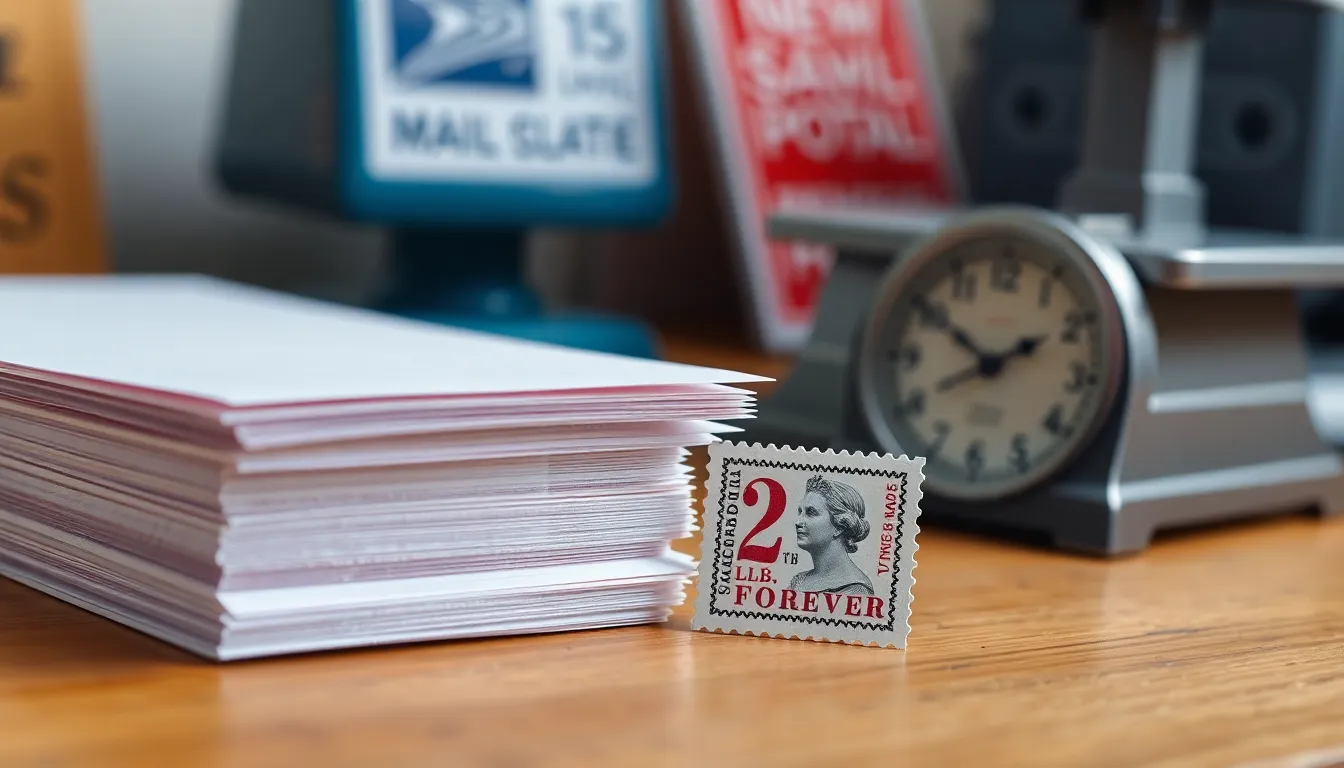When it comes to mailing letters and packages, understanding postage requirements can save time and money. One common question arises: how many pieces of paper can you send per stamp? This query is essential for anyone looking to maximize their postage efficiency while ensuring their mail reaches its destination without any hiccups.
The answer isn’t one-size-fits-all, as it depends on various factors like weight, size, and destination. Knowing the basics of postal regulations can help individuals and businesses alike navigate the complexities of mailing. Whether sending a simple letter or a multi-page document, grasping how stamps work in relation to paper can make a significant difference in overall mailing costs and convenience.
Table of Contents
ToggleUnderstanding Postal Regulations
Understanding postal regulations ensures efficient mailing processes and cost-effectiveness. Factors such as weight, size, and destination significantly influence stamp requirements.
Overview of Stamp Usage
Stamp usage primarily depends on the weight of the item being mailed. For standard letters weighing up to 1 ounce, one Forever stamp suffices. However, items exceeding this weight necessitate additional postage. Each extra ounce typically requires an additional stamp. For packages, the postage varies based on the weight and shipping speed, often demanding weight-based pricing.
Types of Paper for Mailing
Different types of paper impact mailing regulations. Standard paper (20 lb bond) aligns with most mailing needs, including letters and documents. Heavier paper types, such as cardstock, may incur additional postage due to increased weight. Additionally, specific paper sizes must conform to postal guidelines—standard sizes include letter (8.5 x 11 inches) and legal (8.5 x 14 inches). Non-standard sizes may require custom postage rates.
Calculating Pieces of Paper Per Stamp

Understanding how many pieces of paper can be sent per stamp involves considering multiple factors that affect postage requirements. Paper count for a single stamp hinges on weight, size, and specific mailing guidelines.
Factors Influencing Paper Count
- Weight: Weight directly impacts postage. For standard letters, each additional ounce requires more postage. Up to 1 ounce, one Forever stamp suffices, while 1 to 2 ounces requires additional postage, often in the form of another stamp.
- Paper Type: Different types of paper weigh differently. Standard 20 lb bond paper allows for typical mailing, whereas heavier options like cardstock or specialty paper may need extra postage.
- Size: Postal regulations specify sizes for letters. Standard letter size (8.5 x 11 inches) and legal size (8.5 x 14 inches) fall within common guidelines. Non-standard sizes often require different postage calculations and may limit the number of pages sent per stamp.
- Destination: The mailing destination can affect costs. Sending items internationally usually incurs higher postage rates.
- Thickness: Thickness of the mailpiece can also factor in, as overly thick items may necessitate additional postage, regardless of weight or size.
Standard Guidelines for Mailing
The USPS provides clear guidelines for mailing. For standard letters, the following applies:
- 1 ounce: One Forever stamp allows mailing of up to 1 ounce.
- 2 ounces: Requires an additional 20 cents for every ounce beyond the first.
- 3 ounces and above: Each additional ounce mandates further postage.
For multi-page documents, every additional page typically weighs around 0.16 ounces when using standard 20 lb bond paper. Therefore, for letters with multiple pages, maintaining awareness of the total weight helps ensure compliance with mailing regulations.
Adhering to these standards optimizes the mailing process and minimizes costs. Understanding how many pieces of paper a stamp covers helps individuals and businesses manage their postage efficiently.
Real-Life Examples
Understanding real-life mailing scenarios can clarify how many pieces of paper fit under the postage requirements established by the USPS. Several common scenarios and case studies demonstrate these principles in action.
Common Scenarios
- Standard Letters: For a standard letter weighing up to 1 ounce, one Forever stamp covers mailing costs. A single 8.5 x 11-inch sheet of 20 lb bond paper falls within this weight limit, allowing for straightforward postage without additional fees.
- Multi-Page Documents: When mailing multi-page documents, each page typically weighs around 0.16 ounces. Therefore, a five-page document made with standard paper weighs approximately 0.8 ounces. This weight allows it to be mailed with one Forever stamp, provided that the total weight remains under 1 ounce.
- Legal Size Paper: A legal-sized (8.5 x 14 inches) document also requires careful consideration. If it exceeds 1 ounce due to additional pages or heavier paper types, more postage may be necessary. Legal documents, often printed on thicker paper, may incur extra costs.
- Heavy Paper Types: Using heavier paper, such as cardstock, significantly affects postage. A single piece of cardstock generally weighs more than standard paper, often exceeding the 1-ounce limit with only one or two sheets. In this case, multiple postage stamps might be necessary.
Case Studies
- Business Mailing: A company sending out brochures uses 100 lb cardstock and decides to send four-page documents. Each document weighs about 0.48 ounces, requiring one Forever stamp for each, as the weight remains under 1 ounce.
- Personal Letters: An individual mailing a family newsletter consisting of six pages printed on standard 20 lb bond paper anticipates an approximate weight of 0.96 ounces. One Forever stamp suffices, aligning perfectly with USPS guidelines.
- Mixed Media Mailings: An organization combines standard paper and heavy cardstock in a single mailing. The overall document weight comes to 2 ounces. This scenario requires purchasing additional postage based on the total weight exceeding the standard allowance for one stamp.
These examples highlight how the number of pieces of paper per stamp can vary based on specific mailing criteria. Understanding these examples ensures efficient postage handling, helping to maintain mailing budgets while complying with USPS standards.
Alternatives to Traditional Mailing
Various alternatives to traditional mailing exist, offering efficient and effective options for delivery. Exploring these methods can enhance communication while addressing environmental concerns.
Digital Options
Digital communication methods provide faster, cost-effective alternatives. Email serves as a primary choice, allowing immediate document sharing without postage costs. Services like Google Drive or Dropbox facilitate easy file sharing, enabling users to send larger documents without concerns about weight or size. For secure communication, encrypted messaging platforms offer private options that bypass traditional mailing altogether.
Eco-Friendly Solutions
Eco-friendly mailing solutions focus on reducing paper use and resource consumption. Electronic bills and statements minimize paper waste, promoting digital records instead. Using recycled paper for physical mail reduces environmental impact. Additionally, businesses can adopt hybrid mailing services that combine digital notifications with traditional mail, optimizing efficiency while remaining environmentally conscious. Choosing sustainable practices supports both communication needs and ecological responsibility.
Understanding how many pieces of paper can be mailed per stamp is essential for anyone looking to optimize their postage. By taking into account factors like weight size and paper type individuals can streamline their mailing processes. This knowledge not only helps in reducing mailing costs but also ensures compliance with USPS guidelines.
As mailing options continue to evolve it’s crucial to stay informed about both traditional and digital alternatives. Embracing eco-friendly practices alongside efficient postage strategies can lead to more responsible and effective communication. Ultimately being aware of these details empowers senders to make informed decisions that enhance their mailing experience.










